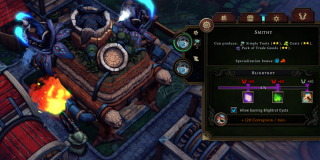Blightrot: Difference between revisions
No edit summary |
No edit summary |
||
| Line 6: | Line 6: | ||
Each Cyst lies dormant at first and brings some positive side effects with it. But during the Storm season, Blightrot Cysts wake up and inflict Corruption upon the Ancient Hearth (indicated by the progress bar above the Hearth and in the Hearth’s UI after selecting it). Once the Corruption bar fills completely, a number of villagers will die. The more Blightrot Cysts are active, the faster Corruption progresses. | Each Cyst lies dormant at first and brings some positive side effects with it. But during the Storm season, Blightrot Cysts wake up and inflict Corruption upon the Ancient Hearth (indicated by the progress bar above the Hearth and in the Hearth’s UI after selecting it). Once the Corruption bar fills completely, a number of villagers will die. The more Blightrot Cysts are active, the faster Corruption progresses. | ||
# The first cyst prevents the building from being demolished | |||
# The second cyst gives all workers +20% movement speed | |||
# The third cyst gives all workers a 25% chance for double production | |||
To combat the spread of Blightrot, you need to build Blight Posts and create a resource called Purging Fire. Blightrot Cysts are invulnerable for most of the year, but during the Storm, they open up and become vulnerable. That’s when Blight Fighters will go around the settlement and burn them down. Removing a Cyst will not only slow down the Corruption process but also remove a bit of the already accumulated Corruption from the Hearth. | To combat the spread of Blightrot, you need to build Blight Posts and create a resource called Purging Fire. Blightrot Cysts are invulnerable for most of the year, but during the Storm, they open up and become vulnerable. That’s when Blight Fighters will go around the settlement and burn them down. Removing a Cyst will not only slow down the Corruption process but also remove a bit of the already accumulated Corruption from the Hearth. | ||
The Ancient Hearth can also be reinforced by building and upgrading other smaller Hearths in your settlement. | The Ancient Hearth can also be reinforced by building and upgrading other smaller Hearths in your settlement. | ||
Revision as of 22:06, 31 October 2022
Blightroot is a mechanic only present on difficulty Veteran or harder.
Every Recipe in production buildings has a Blightrot Footprint. This pollution accumulates and once it reaches 60 a Blightrot Cyst will form. The amount of accumulated Blightrot can be seen in the Blightrot tab in a given building’s UI panel.
Each Cyst lies dormant at first and brings some positive side effects with it. But during the Storm season, Blightrot Cysts wake up and inflict Corruption upon the Ancient Hearth (indicated by the progress bar above the Hearth and in the Hearth’s UI after selecting it). Once the Corruption bar fills completely, a number of villagers will die. The more Blightrot Cysts are active, the faster Corruption progresses.
- The first cyst prevents the building from being demolished
- The second cyst gives all workers +20% movement speed
- The third cyst gives all workers a 25% chance for double production
To combat the spread of Blightrot, you need to build Blight Posts and create a resource called Purging Fire. Blightrot Cysts are invulnerable for most of the year, but during the Storm, they open up and become vulnerable. That’s when Blight Fighters will go around the settlement and burn them down. Removing a Cyst will not only slow down the Corruption process but also remove a bit of the already accumulated Corruption from the Hearth.
The Ancient Hearth can also be reinforced by building and upgrading other smaller Hearths in your settlement.
 Hooded Horse Wikis
Hooded Horse Wikis
